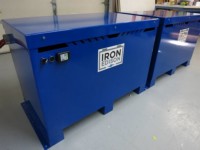Oasis Montana Inc.
|
Oasis Montana Inc. is a woman-owned and operated small Montana business that was incorporated in 1999 that employees 100% minority, disabled veterans. We are proud to have been helping people being energy efficient & energy independent for over 25 years.
- System information
- Example Systems
- Components
- Appliances
- Our company
- Site map
Iron Edison Batteries
These have been discontinued and no
longer available due to supply problems.
*************************
|
If you are thinking about ordering a nickel-iron battery set, we need to hear from you now (before the end of November) for your order to arrive by March. The lead time for these is significant, and next month will be the time to order for those to arrive in April. |
*************************
Nickel Iron Batteries
Do to recent 10% import tariffs
these are now the current prices.
Another price increase is anticipated on January 1st, so if you are interested
in these batteries, get ‘em now!
|
12 volt |
24 volt |
48 volt |
|||
|
Amp Hours |
List Price |
Amp Hours |
List Price |
Amp Hours |
List Price |
|
100 |
$1,210 |
100 |
$2420 |
100 |
$4,840 |
|
200 |
$2,420 |
200 |
$4,840 |
200 |
$9.680 |
|
300 |
$3,630 |
300 |
$7,260 |
300 |
$14,520 |
|
400 |
$4,840 |
400 |
$9,680 |
400 |
$19,360 |
|
500 |
$6,050 |
500 |
$12,100 |
500 |
$24,200 |
|
600 |
$7,260 |
600 |
$14,520 |
600 |
$29,040 |
|
700 |
$8,470 |
700 |
$16,940 |
700 |
$33,880 |
|
800 |
$9,680 |
800 |
$19,360 |
800 |
$38,720 |
|
900 |
$10,890 |
900 |
$21,780 |
900 |
$43,560 |
|
1000 |
$12,100 |
1000 |
$24,200 |
1000 |
$48,400 |
|
|
|
|
|
|
|
| Iron Edison Battery
Company’s Lithium Iron Phosphate batteries offer a
turnkey solution for energy storage needs in a variety of
applications. Iron Edison’s batteries have been successfully
used as solar photovoltaic energy storage in off-grid, grid-tie
with battery backup, and grid backup applications. For supplying a prospective renewable energy battery project, Iron Edison Company proposes the following battery details:
|
Lithium Iron Batteries - 48 Volt
| Amp Hours | List Price | Amp Hours | List Price |
| 180 | $9,920 | 2,100 | $71,700 |
| 360 | $14,900 | 2,800 | $95,500 |
| 540 | $21,300 | 3,500 | $136,500 |
| 700 | $24,600 | 4,200 | $191,000 |
| 1,000 | $35,800 | 4,900 | $222,000 |
| 1,400 | $47,500 | 5,600 | $254,000 |


